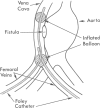Abstract
Six cases of acute aortocaval fistula are reported, which illustrate the difficulties of diagnosis and management in a rare life-threatening condition. Five cases arose from spontaneous rupture of aortic aneurysms and one from trauma. In four cases the diagnosis was made before surgery. Useful diagnostic features included inappropriate jugular venous distension in five patients, lower abdominal and trunk cyanosis in three patients and a palpable thrill in three patients. Preoperative diagnosis permitted attempts to control venous haemorrhage in three cases, one by balloons through the aortic sac and two by transvenous positioning of balloon catheters in the vena cava before aortic opening. The use of transvenous balloon catheters was found to be helpful in reducing haemorrhage. Four patients left hospital alive. Preoperative recognition of the signs of an acute aortocaval rupture and preliminary balloon tamponade appear to be valuable in the management of acute aortocaval fistulas.
Full text
PDF



Images in this article
Selected References
These references are in PubMed. This may not be the complete list of references from this article.
- Alexander J. J., Imbembo A. L. Aorta-vena cava fistula. Surgery. 1989 Jan;105(1):1–12. [PubMed] [Google Scholar]
- Baker W. H., Sharzer L. A., Ehrenhaft J. L. Aortocaval fistula as a complication of abdominal aortic aneurysms. Surgery. 1972 Dec;72(6):933–938. [PubMed] [Google Scholar]
- Buscaglia L. C., Blaisdell F. W., Lim R. C., Jr Penetrating abdominal vascular injuries. Arch Surg. 1969 Dec;99(6):764–769. doi: 10.1001/archsurg.1969.01340180088018. [DOI] [PubMed] [Google Scholar]
- Hildreth D. H., Turcke D. A. Postlaminectomy arteriovenous fistula. Surgery. 1977 May;81(5):512–520. [PubMed] [Google Scholar]
- Ingoldby C. J., Wujanto R., Mitchell J. E. Impact of vascular surgery on community mortality from ruptured aortic aneurysms. Br J Surg. 1986 Jul;73(7):551–553. doi: 10.1002/bjs.1800730711. [DOI] [PubMed] [Google Scholar]
- Mattox K. L., Whisennand H. H., Espada R., Beall A. C., Jr Management of acute combined injuries to the aorta and inferior vena cava. Am J Surg. 1975 Dec;130(6):720–724. doi: 10.1016/0002-9610(75)90428-6. [DOI] [PubMed] [Google Scholar]
- McDonald G. R., Graham K. J., Barratt-Boyes B. G. Aortocaval fistulae: an occasional cause of congestive cardiac failure. Aust N Z J Surg. 1982 Dec;52(6):573–575. doi: 10.1111/j.1445-2197.1982.tb06114.x. [DOI] [PubMed] [Google Scholar]
- Mohr L. L., Smith L. L. Arteriovenous fistaul from rupture of abdominal aortic aneurysm. Arch Surg. 1975 Jul;110(7):806–812. doi: 10.1001/archsurg.1975.01360130038008. [DOI] [PubMed] [Google Scholar]
- Nennhaus H. P., Javid H. The distinct syndrome of spontaneous abdominal aortocaval fistula. Am J Med. 1968 Mar;44(3):464–473. doi: 10.1016/0002-9343(68)90117-4. [DOI] [PubMed] [Google Scholar]
- Olcott C., 4th, Holcroft J. W., Stoney R. J., Wylie E. J. Unusual problems of abdominal aortic aneurysms. Am J Surg. 1978 Mar;135(3):426–431. doi: 10.1016/0002-9610(78)90079-x. [DOI] [PubMed] [Google Scholar]
- Pearce C. W., McCool E., Schmidt F. E. Control of bleeding from cardiovascular wounds: balloon catheter tamponade. Ann Surg. 1966 Feb;163(2):257–259. doi: 10.1097/00000658-196602000-00016. [DOI] [PMC free article] [PubMed] [Google Scholar]
- Reckless J. P., McColl I., Taylor G. W. Aorto-caval fistulae: an uncommon complication of abdominal aortic aneurysms. Br J Surg. 1972 Jun;59(6):461–462. doi: 10.1002/bjs.1800590614. [DOI] [PubMed] [Google Scholar]
- Steenblock D. A., Celander D. R. A light and electron microscopic study of arteries and other tissues from dogs subjected to chronic fibrinolytic inhibition with AMCHA. Vasc Surg. 1968 Sep;2(3):149–156. doi: 10.1177/153857446800200304. [DOI] [PubMed] [Google Scholar]



